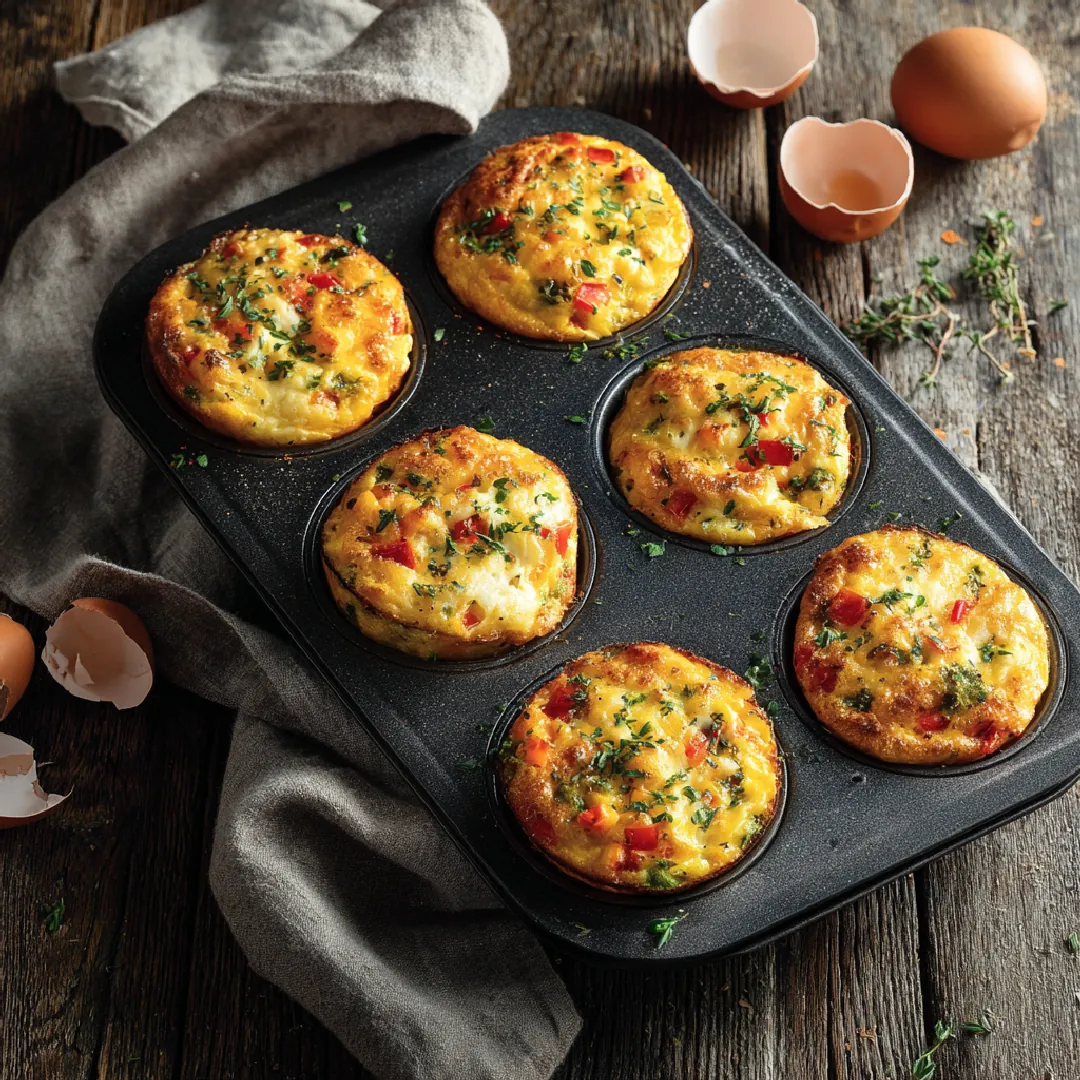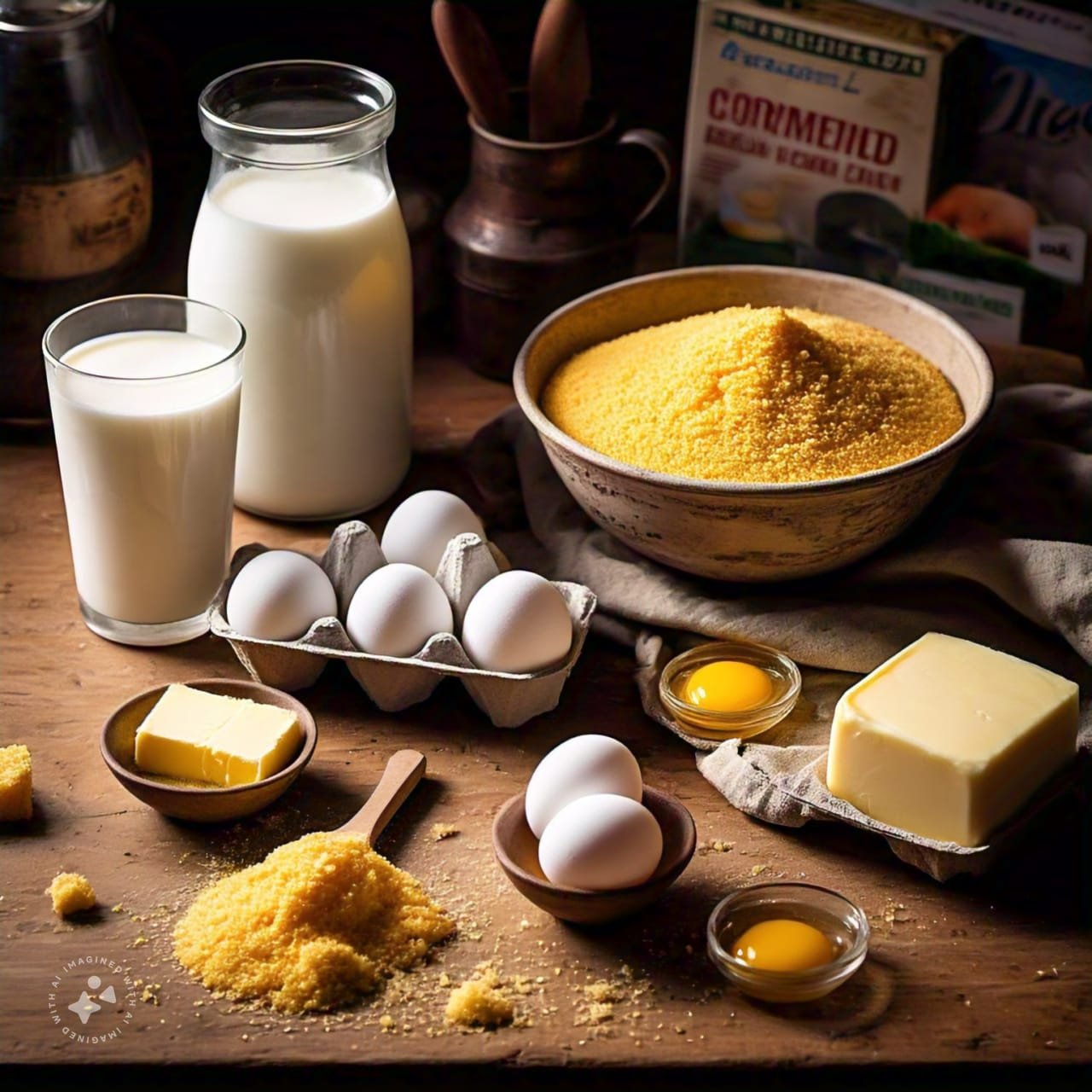Table of Contents
Introduction
There’s nothing quite like a bowl of creamy, homemade ice cream on a warm day. Yet, crafting ice cream that rivals store-bought varieties in texture and smoothness can be a challenge. Choosing the best thickener for homemade ice cream can transform your dessert into a creamy masterpiece. Thickeners stabilize the ice cream mixture, preventing the formation of ice crystals and enhancing its rich, velvety consistency. Whether you’re working with classic custard recipes or vegan alternatives, choosing the best thickener is key to perfecting your frozen dessert.
But with so many thickening agents to choose from—cornstarch, egg yolks, gelatin, and plant-based gums, to name a few—how do you decide which one is best for your recipe? This article delves into the top thickeners for homemade ice cream, exploring their benefits, uses, and how they impact texture. Whether you’re a novice or a seasoned home cook, this guide will help you find the ideal thickener for your creamy creations.
Why Use a Thickener in Ice Cream?
Crafting homemade ice cream isn’t just about flavor; texture plays an equally vital role. Without the right texture, even the most delicious ice cream can fall short. This is where thickeners come into the picture. They are essential for stabilizing the mixture, ensuring your ice cream is smooth, creamy, and free from unpleasant ice crystals.
The Role of Thickeners in Ice Cream
Thickeners work behind the scenes to perfect your frozen dessert. Here’s how they contribute to the process:
- Prevent Ice Crystals: During the freezing process, water in the mixture can form crystals. Thickeners reduce the size of these crystals, creating a smoother texture.
- Improve Creaminess: They enhance the overall mouthfeel, giving ice cream its luxurious and creamy consistency.
- Enhance Structure: Thickeners stabilize the emulsion of fat, sugar, and water in the mixture, keeping everything cohesive and uniform.
- Aid Churning Process: By thickening the base, they help the mixture churn evenly, making it easier to incorporate air for lightness.
Common Issues Without Thickeners
When ice cream is made without a stabilizer or thickener, several issues may arise:
- Icy Texture: The water in the mixture can freeze into large crystals, leading to a gritty or crunchy mouthfeel.
- Separation: Without stabilization, fats and liquids can separate, affecting both texture and appearance.
- Inconsistent Freezing: The absence of thickening agents can cause uneven freezing, resulting in a product that’s either too soft or too hard.
How Thickening Impacts Flavor
While thickeners primarily affect texture, they also influence how flavors are perceived. A smoother texture allows flavors to linger on the palate, enhancing the overall experience. Some thickeners, like egg yolks, even add a subtle richness that complements many ice cream recipes.
Top Thickeners for Homemade Ice Cream
When it comes to selecting the best thickener for homemade ice cream, you’ll find a variety of options, each with unique characteristics. Some thickeners are traditional, like egg yolks, while others, such as xanthan gum, are modern alternatives. The best choice depends on the type of ice cream you’re making and your dietary preferences.
Cornstarch
Overview: Cornstarch is a popular thickener for many desserts, including ice cream. It works by absorbing liquid and forming a gel-like consistency when heated.
Benefits:
- Affordable and widely available.
- Easy to use, especially for beginners.
- Works well in both dairy and non-dairy recipes.
Drawbacks: - Can impart a slightly starchy taste if not cooked thoroughly.
- Requires heating, which may not suit all recipes.
Usage Tip: Dissolve cornstarch in a small amount of cold milk or cream before adding it to the ice cream base to avoid lumps.
Egg Yolks
Overview: Egg yolks are a classic thickener used in custard-based ice creams, also known as French-style ice creams. They add richness and create a luxurious texture.
Benefits:
- Adds natural emulsification, improving creaminess.
- Enhances flavor with a subtle richness.
- Versatile and works well with a wide range of ingredients.
Drawbacks: - Requires tempering to prevent curdling.
- Not suitable for vegan recipes.
Usage Tip: Whisk the egg yolks with sugar and temper them by slowly adding warm milk or cream before cooking the mixture to thicken.
Gelatin
Overview: Gelatin is a protein-based thickener that stabilizes and thickens ice cream mixtures.
Benefits:
- Prevents ice crystals effectively.
- Adds a soft, smooth mouthfeel.
- Works without altering the flavor.
Drawbacks: - Not suitable for vegetarians or vegans.
- Can result in a slightly firm texture if overused.
Usage Tip: Soften gelatin in cold water before dissolving it in the warm ice cream base.
Xanthan Gum
Overview: Xanthan gum is a modern thickener, commonly used in gluten-free and vegan recipes. A small amount goes a long way.
Benefits:
- Highly effective in small quantities.
- Works in both hot and cold mixtures.
- Perfect for vegan and gluten-free ice creams.
Drawbacks: - Can lead to a slimy texture if overused.
- Requires careful measurement for best results.
Usage Tip: Blend xanthan gum with dry ingredients before adding to liquids to ensure even dispersion.
Agar-Agar
Overview: Agar-agar, derived from seaweed, is a plant-based alternative to gelatin.
Benefits:
- Excellent for vegan recipes.
- Provides a firm but smooth texture.
- Heat-stable and easy to use.
Drawbacks: - Can make the ice cream slightly harder if overused.
- Requires heating to activate.
Usage Tip: Dissolve agar-agar in a small amount of water or milk before incorporating it into the ice cream base.
Guar Gum
Overview: Guar gum is another plant-based thickener derived from guar beans.
Benefits:
- Works well in small amounts.
- Enhances creaminess and reduces ice crystal formation.
- Ideal for vegan and gluten-free recipes.
Drawbacks: - Can produce a gummy or sticky texture if overused.
- Needs precise measurement.
Usage Tip: Add guar gum to dry ingredients before mixing with the liquid base for uniform thickening.
Cornstarch: A Simple, Effective Thickener for Homemade Ice Cream
Cornstarch is one of the most accessible and beginner-friendly thickeners for homemade ice cream. This common pantry staple is widely used in both traditional and modern ice cream recipes due to its simplicity and effectiveness.
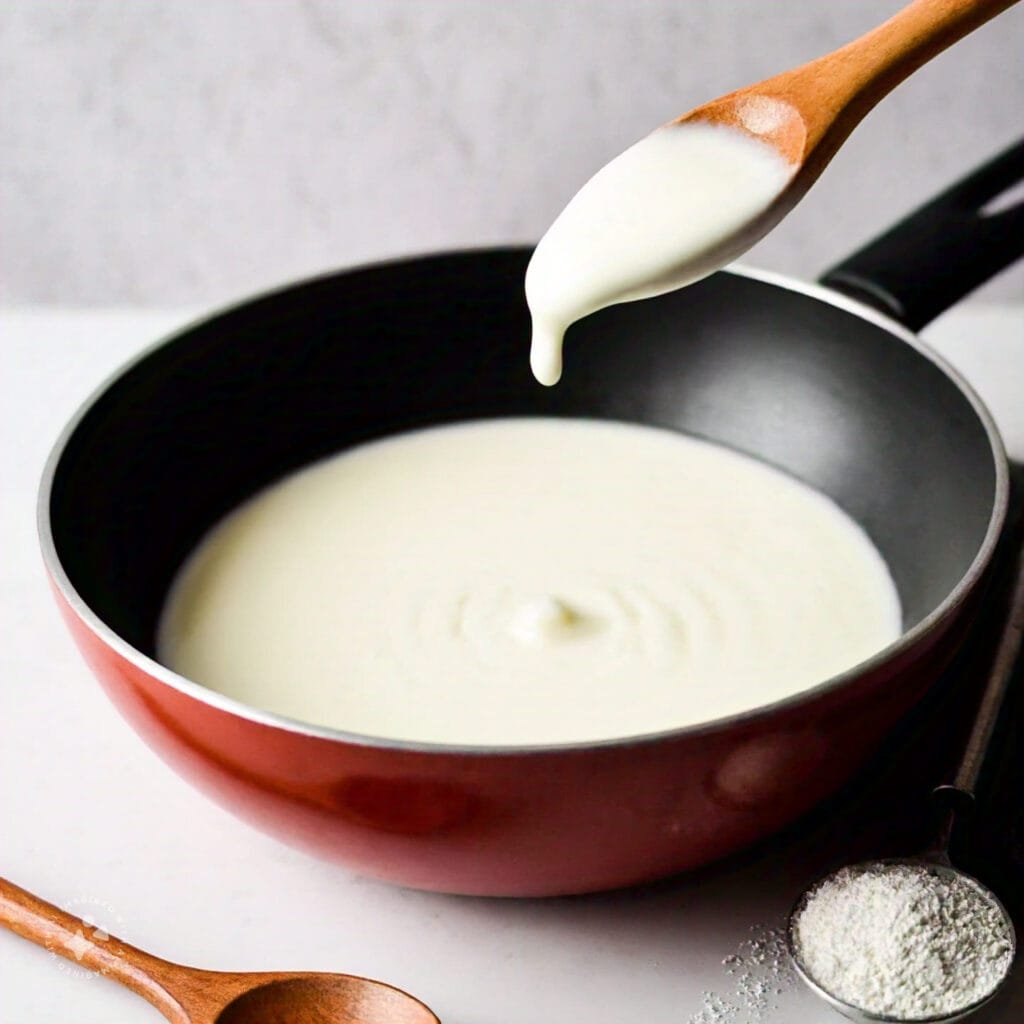
How Cornstarch Works as a Thickener
Cornstarch thickens by absorbing water and swelling when heated, forming a gel-like consistency. This property helps stabilize the ice cream mixture and prevents the formation of large ice crystals during freezing. The result is a smoother, creamier dessert.
Benefits of Using Cornstarch
1. Easy to Find: Cornstarch is inexpensive and readily available in most grocery stores, making it an ideal option for home cooks.
2. Simple Preparation: It doesn’t require specialized knowledge or equipment to use effectively.
3. Neutral Flavor: When properly cooked, cornstarch doesn’t affect the taste of the ice cream, allowing other flavors to shine.
4. Works with Dairy and Non-Dairy Bases: Cornstarch is versatile enough to be used in milk, cream, almond milk, or other plant-based alternatives.
Step-by-Step Guide to Using Cornstarch
To use cornstarch effectively in your homemade ice cream, follow these steps:
- Prepare a Slurry: Dissolve 2-3 tablespoons of cornstarch in a small amount of cold liquid (water, milk, or cream). This prevents lumps from forming.
- Heat the Base: Warm your ice cream mixture on the stove, but don’t let it boil. Gradual heating is key to avoiding clumps.
- Incorporate the Slurry: Slowly add the cornstarch mixture to the warm base while stirring continuously. This ensures even distribution.
- Cook Until Thickened: Continue cooking over medium heat, stirring frequently, until the mixture thickens slightly. You’ll know it’s ready when it coats the back of a spoon.
- Cool Before Churning: Allow the base to cool completely before pouring it into your ice cream maker.
Tips for Success with Cornstarch
- Avoid Overuse: Adding too much cornstarch can result in a pudding-like consistency rather than creamy ice cream. Stick to recommended measurements.
- Cook Thoroughly: Undercooked cornstarch can leave a starchy taste. Ensure the mixture is fully heated to activate its thickening properties.
- Combine with Other Ingredients: Cornstarch works well when paired with ingredients like milk powder or a small amount of cream cheese for added stability and richness.
Cornstarch offers an easy way to elevate your homemade ice cream without requiring specialized thickeners. For those new to ice cream making, it’s an excellent starting point that yields consistently satisfying results.
Egg Yolks: The Traditional Thickener
Egg yolks have been a staple in ice cream making for centuries, especially in French-style, custard-based recipes. They are a natural thickener and emulsifier, giving ice cream its characteristic richness and creamy texture.
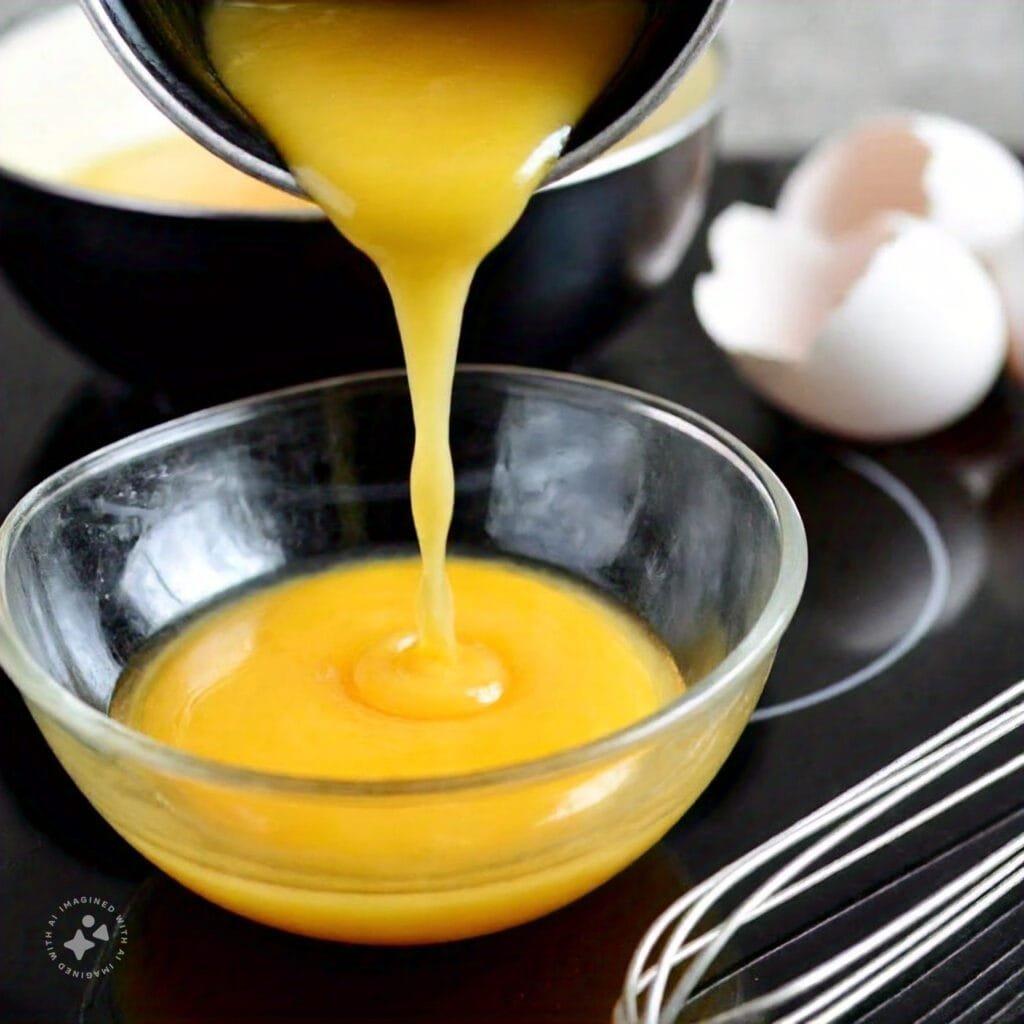
Why Egg Yolks Are Popular in Ice Cream
1. Natural Emulsification: Egg yolks contain lecithin, a natural emulsifier that binds water and fat molecules. This prevents separation and ensures a smooth, cohesive texture.
2. Luxurious Creaminess: The fats and proteins in egg yolks enhance the mouthfeel of ice cream, making it rich and velvety.
3. Flavor Enhancer: Egg yolks add a subtle depth of flavor, complementing many ice cream varieties.
How to Use Egg Yolks as a Thickener
Egg yolks are typically used in custard-based ice creams, where they are cooked with milk or cream to thicken the base. The process requires care to avoid curdling.
Step-by-Step Guide:
- Separate the Yolks: For most recipes, use 4-6 egg yolks per quart of ice cream base.
- Whisk with Sugar: Beat the yolks with sugar until the mixture is pale and slightly thickened. This step prevents the yolks from cooking too quickly.
- Temper the Yolks: Heat the milk or cream until warm but not boiling. Gradually pour a small amount of the warm liquid into the yolk mixture while whisking continuously. This tempers the yolks, preventing them from curdling.
- Combine and Cook: Return the tempered yolk mixture to the saucepan with the remaining milk or cream. Cook over medium heat, stirring constantly, until the mixture thickens and coats the back of a spoon.
- Cool and Chill: Strain the mixture through a fine sieve to remove any cooked bits, then cool completely before churning.
Benefits of Using Egg Yolks
- Time-Tested Tradition: Many classic recipes rely on egg yolks for their dependable results.
- Enhanced Richness: The addition of egg yolks creates a custard-like base that’s indulgent and satisfying.
- Versatile Application: Egg yolks pair well with a wide variety of flavors, from vanilla to chocolate to fruit-based ice creams.
Potential Drawbacks
Despite their advantages, egg yolks do have some limitations:
- Not Suitable for Vegan Recipes: Egg yolks are not an option for those following a plant-based diet.
- Requires Precise Cooking: If the yolks are overheated, they can curdle and ruin the texture of the base.
- Allergen Concerns: Eggs are a common allergen, so alternative thickeners may be needed for some individuals.
Tips for Success with Egg Yolks
- Use Fresh Eggs: Fresh, high-quality eggs produce the best results.
- Cook Slowly: Patience is key to avoiding curdling. Low and slow heat ensures a smooth, thickened base.
- Combine with Other Thickeners: For added stability, some recipes pair egg yolks with a small amount of cornstarch or gelatin.
Egg yolks are a go-to choice for those seeking traditional, premium-quality ice cream. While they require a bit more technique than some other thickeners, their ability to deliver unparalleled creaminess makes them worth the effort.
Best Vegan and Plant-Based Thickeners for Homemade Ice Cream
For those who follow a vegan or plant-based diet, there are excellent alternatives to traditional thickeners like egg yolks and gelatin. These options are derived from plants and are equally effective in creating creamy, stable ice cream. Here are the top vegan-friendly thickeners:
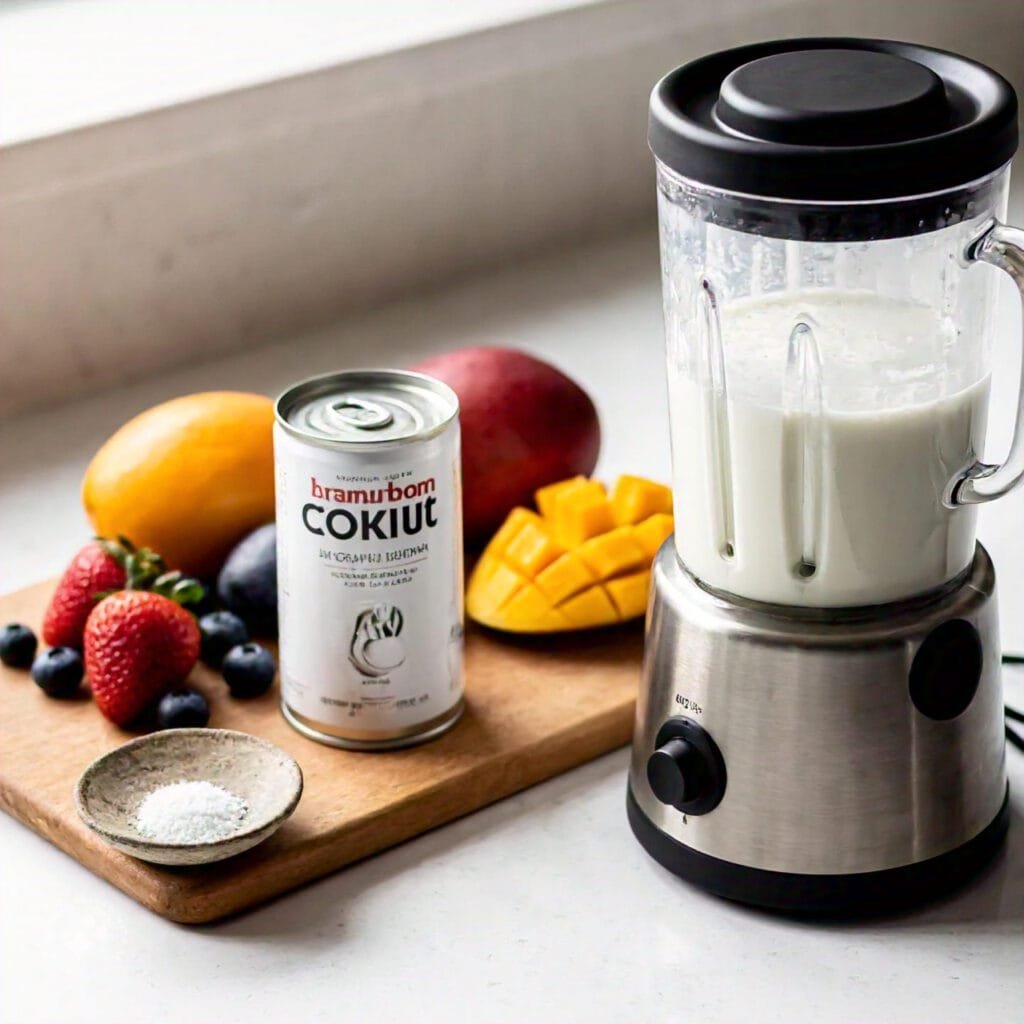
Xanthan Gum
Overview: Xanthan gum is a widely used thickener in gluten-free and vegan cooking. It is a polysaccharide produced through fermentation and is highly effective in small amounts.
Benefits:
- Works with hot or cold mixtures, making it versatile.
- Creates a creamy texture by stabilizing the emulsion of fats and liquids.
- Prevents ice crystals for smooth ice cream.
Drawbacks:
- Overusing xanthan gum can result in a slimy or gummy texture.
- Requires precise measurement; even a small excess can alter the consistency.
Usage Tip: Mix xanthan gum with dry ingredients before blending it into the ice cream base to prevent clumping. Typically, 1/8 to 1/4 teaspoon is sufficient for most recipes.
Agar-Agar
Overview: Derived from red algae, agar-agar is a natural, plant-based alternative to gelatin. It is commonly used in vegan desserts and works well as a thickener in ice cream.
Benefits:
- Heat-stable and easy to work with.
- Adds firmness without compromising creaminess.
- Neutral flavor that doesn’t overpower other ingredients.
Drawbacks:
- Overuse can make the ice cream slightly hard or brittle.
- Must be dissolved in liquid and heated to activate.
Usage Tip: Dissolve 1-2 teaspoons of agar-agar powder in a small amount of water or plant-based milk. Heat until fully dissolved, then mix into the ice cream base.
Guar Gum
Overview: Guar gum is made from guar beans and is another effective plant-based thickener. It is particularly popular for vegan and gluten-free recipes due to its powerful thickening properties.
Benefits:
- Highly effective in tiny amounts, reducing the risk of altering the flavor.
- Prevents separation and enhances creaminess.
- Works well with non-dairy milks like almond, soy, or coconut.
Drawbacks:
- Overuse can lead to a sticky or overly gummy texture.
- Requires precise weighing for consistent results.
Usage Tip: Like xanthan gum, guar gum should be blended with dry ingredients or dissolved thoroughly to avoid clumps. Use about 1/4 teaspoon for a quart of ice cream base.
Coconut Cream
Overview: While not a traditional thickener, coconut cream adds richness and stabilizes vegan ice cream bases naturally. Its high fat content mimics the creaminess of dairy.
Benefits:
- Readily available and easy to use.
- Enhances flavor, especially in tropical or chocolate-based ice creams.
- Provides natural creaminess without additional stabilizers.
Drawbacks:
- Imparts a distinct coconut flavor that may not complement all recipes.
- Lower stabilizing power compared to gums or agar-agar.
Usage Tip: Use coconut cream as a base ingredient or combine it with a gum or starch for added thickness and stability.
Tips for Choosing Vegan Thickeners
When selecting a plant-based thickener, consider the following:
- Flavor Compatibility: Ensure the thickener doesn’t clash with your chosen flavors. For instance, coconut cream works well with tropical or chocolate flavors but may overpower delicate fruit-based recipes.
- Texture Preferences: If you want a soft, creamy texture, opt for xanthan gum or guar gum. For firmer textures, agar-agar is a better choice.
- Allergies and Sensitivities: Check for any potential allergens, especially if you’re cooking for others.
Vegan thickeners open up a world of possibilities for creating plant-based ice creams with textures rivaling traditional recipes. Experimenting with these ingredients can help you find the perfect combination for your dietary needs and taste preferences.
Blending Multiple Thickeners
Combining two or more thickeners is a technique used by professional chefs and ice cream makers to achieve optimal texture and stability. By blending thickeners, you can take advantage of their individual strengths and minimize their drawbacks, resulting in a perfectly creamy and scoopable homemade ice cream.

Why Combine Thickeners?
1. Enhanced Stability: A combination of thickeners can better stabilize the mixture, reducing the risk of ice crystal formation.
2. Balanced Texture: Some thickeners, like xanthan gum, add creaminess, while others, such as egg yolks or agar-agar, contribute firmness. Using both creates a balanced texture.
3. Versatility: Blending thickeners allows you to tailor your recipe to different bases, such as dairy or plant-based alternatives.
4. Minimized Drawbacks: Combining thickeners can reduce issues like sliminess (from gums) or excessive hardness (from gelatin or agar-agar).
Popular Thickener Combinations
1. Cornstarch + Egg Yolks:
- Cornstarch provides extra thickening power, while egg yolks enhance richness and emulsification.
- Ideal for custard-based recipes requiring added stability.
Usage Tip: Use 2 tablespoons of cornstarch and 4 egg yolks per quart of ice cream base. Temper the egg yolks and dissolve the cornstarch in a small amount of cold liquid before cooking the mixture.
2. Xanthan Gum + Coconut Cream:
- Xanthan gum prevents ice crystal formation, while coconut cream adds natural creaminess and richness.
- Perfect for vegan ice creams with tropical or chocolate flavors.
Usage Tip: Add 1/4 teaspoon of xanthan gum and 1 cup of coconut cream to your non-dairy base. Blend thoroughly for even dispersion.
3. Agar-Agar + Guar Gum:
- Agar-agar adds firmness, while guar gum improves creaminess and prevents separation.
- Works well in plant-based ice creams where stability is key.
Usage Tip: Dissolve 1 teaspoon of agar-agar in hot liquid and combine with 1/4 teaspoon of guar gum, ensuring both are evenly distributed in the mixture.
Best Practices for Blending Thickeners
1. Use Precise Measurements: Small quantities of thickeners can have a significant impact. Use a kitchen scale or measuring spoons to ensure accuracy.
2. Dissolve Completely: Each thickener should be fully dissolved or hydrated before blending to avoid clumping or uneven textures.
3. Test and Adjust: The ratio of thickeners may need adjustment based on your recipe and personal preference. Start small and tweak as needed.
4. Match Thickeners to Your Base: For dairy-based recipes, egg yolks and cornstarch work well. For plant-based options, gums or coconut cream are better suited.
Examples of Blended Recipes
1. Vanilla Custard Ice Cream (Cornstarch + Egg Yolks):
- Ingredients: Whole milk, heavy cream, sugar, vanilla extract, egg yolks, and cornstarch.
- Process: Heat milk and cream, temper egg yolks, and stir in cornstarch slurry. Cook until thickened and proceed with chilling and churning.
2. Vegan Chocolate Ice Cream (Xanthan Gum + Coconut Cream):
- Ingredients: Coconut milk, coconut cream, cocoa powder, sugar, and xanthan gum.
- Process: Blend dry ingredients, heat the mixture, and cool before churning.
Blending thickeners is a game-changer in ice cream making, offering greater control over texture and flavor. By experimenting with combinations, you can create a dessert that’s perfectly tailored to your preferences.
Common Mistakes to Avoid When Using Thickeners
Using thickeners in homemade ice cream can be transformative, but mistakes in the process can negatively impact the final product. Understanding common pitfalls will help you achieve consistently creamy and stable results.
Overusing Thickeners
The Problem: Adding too much thickener can lead to overly dense or gummy textures that feel heavy or unpleasant.
Solution: Follow the recommended measurements in your recipe. If experimenting, start with the smallest effective quantity and increase gradually if needed.
Underusing Thickeners
The Problem: Using too little thickener may leave the ice cream unstable, resulting in icy textures and separation during freezing.
Solution: Ensure the thickener quantity matches the liquid volume. A general rule is:
- 2-3 tablespoons of cornstarch per quart of liquid.
- 1/4 teaspoon of xanthan gum per quart.
- 4-6 egg yolks for custard bases.
Failing to Dissolve or Hydrate Thickeners Properly
The Problem: Undissolved thickeners can create clumps or uneven textures in the ice cream base.
Solution:
- Cornstarch or Agar-Agar: Dissolve in a small amount of cold liquid before adding to the base.
- Gums (Xanthan, Guar): Blend with dry ingredients or use a high-speed blender to ensure even distribution.
- Gelatin: Soak in cold water to bloom before heating it in the base.
Not Tempering Egg Yolks Properly
The Problem: If egg yolks are added directly to hot liquid, they can curdle, forming unpleasant lumps.
Solution: Temper the yolks by slowly whisking in warm liquid before returning the mixture to the pot. This prevents sudden heat changes that cause curdling.
Ignoring the Impact of Freezing
The Problem: Ice cream’s texture changes significantly during freezing, and improper thickener use can lead to excessive hardness or softness.
Solution: Keep in mind that thickeners influence how water freezes in the mixture. Gums like xanthan and guar are excellent for reducing ice crystal formation, while cornstarch adds body without hardening the base.
Choosing the Wrong Thickener for the Recipe
The Problem: Certain thickeners may not suit specific types of ice cream or dietary needs. For example, egg yolks are unsuitable for vegan recipes, and agar-agar may make a dairy base too firm.
Solution: Match the thickener to the recipe and dietary requirements:
- Use egg yolks for custard bases.
- Opt for gums or coconut cream for vegan recipes.
- Select cornstarch for simplicity and versatility.
Overheating or Undercooking the Base
The Problem: Overheating can break down the thickener, while undercooking can leave a starchy or gritty taste.
Solution:
- Cook the base over medium heat, stirring constantly until it thickens. Avoid boiling, as this can damage certain thickeners like egg yolks or gelatin.
Failing to Cool the Base Properly
The Problem: Churning a warm base can result in poor texture and slow freezing, affecting the final consistency.
Solution: After cooking, allow the base to cool to room temperature, then chill it in the refrigerator for at least 4 hours before churning.
Skipping Practice and Experimentation
The Problem: Homemade ice cream can be unpredictable, especially when trying new recipes or ingredients.
Solution: Experiment with different thickeners and techniques to find what works best for your preferences. Keep notes on your successes and failures to refine your method.
By avoiding these common mistakes, you can master the art of using thickeners in homemade ice cream, ensuring smooth, creamy, and professional-quality results every time.
FAQs About Ice Cream Thickeners
To help you make the best decisions when choosing and using thickeners for homemade ice cream, here are answers to some frequently asked questions.
What is the best thickener for vegan ice cream?
Answer: The best thickener for vegan ice cream depends on the desired texture and flavor. Xanthan gum and guar gum are excellent for creating creamy textures with minimal quantities. Agar-agar is a great option for firmer results, while coconut cream adds richness to plant-based recipes. For the smoothest results, a combination of xanthan gum and coconut cream is highly recommended.
Can I use flour instead of cornstarch?
Answer: While flour can be used as a thickener, it is not ideal for ice cream. Flour requires longer cooking times to eliminate its raw taste, and even then, it may leave a slightly grainy texture. Cornstarch is a better choice because it thickens quickly and produces a smoother, cleaner result.
What’s the easiest thickener for beginners?
Answer: Cornstarch is the easiest thickener for beginners. It is widely available, simple to use, and forgiving compared to more precise thickeners like gums. Cornstarch thickens quickly without affecting the flavor of your ice cream.
Why does my ice cream turn icy even with a thickener?
Answer: Ice crystals may form if the base isn’t properly stabilized or if it is churned or frozen incorrectly. To avoid iciness:
- Use a thickener like xanthan gum or egg yolks to prevent water separation.
- Chill the base thoroughly before churning.
- Freeze the ice cream quickly after churning to minimize ice crystal formation.
Is gelatin a good choice for ice cream?
Answer: Gelatin is an effective thickener for dairy-based ice cream, offering a smooth texture and excellent stability. However, it is not suitable for vegetarian or vegan recipes. Agar-agar is a plant-based alternative that provides similar results.
By addressing these common questions, you’re now better equipped to select and use the ideal thickener for your homemade ice cream recipes.
Conclusion
Achieving the perfect texture in homemade ice cream is as much about science as it is about creativity. The choice of a thickener plays a pivotal role in delivering the creamy, smooth, and scoopable results that everyone loves. From classic options like egg yolks and cornstarch to modern vegan alternatives such as xanthan gum and agar-agar, each thickener offers unique benefits and challenges.
Understanding the strengths and limitations of each thickening agent can help you make informed choices based on your recipe, dietary preferences, and desired texture. Whether you prefer the traditional richness of custard-based ice creams or the innovative flexibility of plant-based recipes, there’s a thickener to suit every need.
Experimentation is key. By trying different thickeners and combinations, you can customize your ice cream recipes to achieve the perfect balance of creaminess, stability, and flavor. With these insights, you’re ready to elevate your homemade ice cream game and enjoy professional-quality results right from your kitchen.
With this guide, you’re ready to select the best thickener for homemade ice cream and create desserts that rival the pros.
You might also like:


